
 |
|||||
|
|
|||||
|
|
|
|||||
|
|
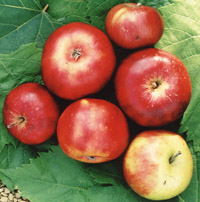 |
DEVONSHIRE QUARRENDEN A very old dessert apple, mentioned by Worlidge in his Vinetum Britannicum of 1678. It might derive its name from Carentan, a traditional apple growing district of Normandy. It is one of the best early apples, with attractive fruit of stunning deep red. The apples have a strawberry flavour and are sweet, juicy and crisp. Upright, spreading trees. It is tolerant of wind and rain, and is extensively cultivated in Devon, where it thrives. It is also grows well in the north. Ripe in August, it does not store for long. Pollination Group 4 |
||
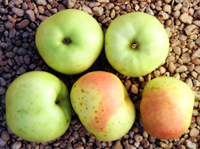 |
DIRLETON APPLE Nothing was known of this apple after 1843, when it was awarded a bronze medal by the Caledonian Horticultural Society to the raiser, the schoolmaster at Dirleton, Mr James Henderson. Though it had been planted at the Walled Garden at Dirleton, just a stone’s throw from the School House, it was no longer there. The search was begun by Hamish McGregor, a relative of James Henderson who possessed the medal itself, and a considerable amount of time was devoted to the search by Bill Anderson, a long time friend of ours in Dirleton, East Lothian, and by ourselves. The apple was found! Since we cannot do full justice here to the full tale around this, we refer the reader to an article on our website. This is a medium to large sized apple with green skin, turning yellow, with a warm blush, slightly ribbed, a little flattened and ripe in late September with us, but probably October in Dirleton. The apple was initially called Henderson’s Keeper, but underwent a name change when it came to the medal – Dirleton Apple. The apples will store for a month or two. Pollination Group 4 |
|||
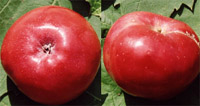 |
DIRLETON
RED A stunning ornamental tree, as well as a very palatable apple
for culinary use. It was introduced to us by Bill Anderson, a construction
engineer for oil and process industries, who had long admired the mature
tree over his neighbour’s fence and treated himself to the apples
in salads and drinks. The tree is in Dirleton, a village in East Lothian,
Scotland, where the Firth of Forth, from Edinburgh, opens into the North
Sea. Open to the north east winds, the tree is clearly very hardy. It
is one of those curious trees that has copper tinted young foliage, dark
coloured bark, especially on young stems, and red staining inside the
wood. The apples are deep red. Like Bundy’s Ringwood Red (above)
it probably has some ancestry from Malus Niedzwetzkyana, an all-over red
tinted crab, with which it has much in common, but the fruit is larger
and without the astringent bitterness of the crab. The blossom is quite
stunning. It flowers readily from almost all one year old buds, as well
as mature spurs, with petals of the richest deep carmine pink. The apples
are translucent deep red over deep pink, usually flattened round, but
occasionally conical. The flesh is crisp and juicy, with a little sweetness
but quite tart – it is also stained, from the skin to the core,
with deep pink. Spur bearing. Thanks to Bill Anderson for sending apples
and scionwood. Pollination Group 3 |
|||
|
DISCOVERY
An early dessert apple, raised in Essex in the mid twentieth century and
introduced in 1963. It was probably a cross between Worcester Pearmain
and Beauty of Bath. Medium sized fruit, with a bright red flush, and a
good fresh flavour. The flesh stays crisp for longer than that of most
early apples. Slow to crop, but crops are then quite heavy. The blossom
shows some resistance to frost so it is a good variety for cold areas.
Part tip-bearing, but willing to set spurs. Pollination Group 5 |
|||
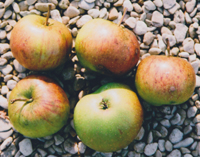 |
DOMINE
Hogg in his ‘British Pomology’ of 1851 says ‘In a notebook
in the possession of Sir John Trevelyan, of Nettlecombe, near Taunton,
which was kept by one of his ancestors, from the year 1580 to 1584, is
an entry of “The names of Apelles, which I had there graffes from
Brentmarch, from one Mr Pace”’. Included in this list is Domine
Quo Vadis. The name is of biblical origin and means ‘Lord, where
are you going?’ and refers to a meeting between the reincarnated
Jesus and the apostle Peter when the latter was fleeing Rome. It seems
very likely that this apple is the same as the ‘Donime Couadis’
of Parkinson (1629) who considered it a French apple, though it might
have come on a longer journey, from anywhere. Why a literate and knowledgeable
man, such as Parkinson, should spell it that way is a mystery. Perhaps,
at a time when hostility to Catholics was prevalent, he thought it politic
to remove any Papist association. It is also interesting that William
Forsyth had an apple called Covadies in a list in 1802 as did nurseryman
Mackie, of Norwich, in 1812, and the supplemental list of John Scott,
‘The Orchardist’ (1872) had an apple called Cowdies. It is
not uncommon for really old apples to drift in their naming over centuries.
Possibly it became known simply as Domine, which has been in America for
200 years and which we received here at the start of the millennium. By
1817, Domine had appeared in America, subsequently acquiring seven synonyms
with the word ‘English’ in the name. William Coxe in his “A
View of The Cultivation of Fruit Trees” wrote “The Domine’
(our note – the apostrophe would seem to suggest that this name
was abbreviated) was imported from England; the tree is remarkably handsome,
tall, upright, and spreading, and of luxuriant growth; the fruit is large
and fair: the colour a greenish yellow, with a blush towards the blossom
end; the stalk is thick and short, planted in a large hollow, as is also
the crown – the flesh is firm, juicy, rich, and of a fine flavour.
It ripens in October, and bears abundantly.” In 1826 an apple of
this name was in the collection catalogue of the London Horticultural
Society and also in the 1831 and 1842 editions, but not described in any.
In the Proceedings of the Royal Horticultural Society, 1862-5, it was
said to be large, roundish, greenish yellow, with a blush of red and for
kitchen use. In America, Elliott (1854) described it and said the origin
was unknown, followed by Downing from 1865 to 1876. Warder (1867) said
it was supposed to be an American native, but the origin was unknown.
Beach (1903) assembled all the prior descriptions and assumed the origin
unknown. There is no evidence to suggest it was American. Descriptions
vary about the length of the stalk. Coxe’s engraving and description
showed a short fat stalk. Elliott described a long slender stalk. Warder’s
plate showed a short stalk deeply set, Downing’s line drawing showed
a long slender stalk, while Beach’s plate showed a medium length
stalk. Otherwise, all the descriptions could be said to be reasonably
consistent. Downing doubted that the apple he saw was the same as that
known to Coxe, because of the different stalk descriptions. We have noticed
that some apples on our trees have short stout stalks in some years and
long and slender ones in others. This (and other observations) show the
dangers of describing apple anatomy in detail from a single viewing and
is a caution to those who accept them. Both Scott (1872) and Hogg (1884)
copied the description of Downing, in America, and we repeat the latter
here. “Fruit of medium size, flat. Skin lively greenish yellow in
the shade, with stripes and splashes of bright red in the sun, and pretty
large russet specks. Stalk long and slender, planted in a wide cavity
and inclining to one side. Calyx small, in a broad basin, moderately sunk.
Flesh white, exceedingly tender and juicy, with a sprightly pleasant,
but not high flavour. Young wood of a smooth, lively light brown, and
the trees are very hardy, and the most rapid growers and prodigious early
bearers that we know – the branches being literally weighed down
by the rope-like clusters of fruit.” That is the apple we seem to
have with us now. The scions were provided by the late Nick Botner, a
truly great collector/conserver and a very rare man. Pollination Group
6 |
|||
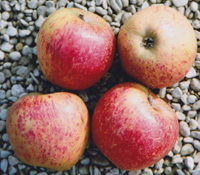 |
DONHEAD
HOUSE An old
dessert apple introduced to us by David Godden of Donhead St. Andrew.
Donhead House is at Donhead St. Andrew, in Wiltshire, but very close to
Shaftesbury in Dorset. A single apple tree grows in a walled garden. The
groundsman says that the tree looked much the same 40 years ago. Before
1895 the property was a rectory. The 1840 tithe map shows the apple tree
position to be within the ‘yards, garden and plantations’
of the rectory. This tree looks very old and would therefore have been
associated with the 18th century rectory. A map of 1768 shows the area
marked as ‘Kitchen Mead’ is within the rectory grounds. It
is unlikely that the tree would have been planted on its own but the rest
of the rector’s orchard is gone and this apple seems the sole survivor.
The tree branches very low and there is no evidence of a graft union,
suggesting the possibility that ground level has changed or perhaps it
was a seedling. The tree might have regrown from a decayed trunk and grown
into the space. The current trunk has a fluted bottom with some wide fissures.
The weathered bark shows it is no longer growing at low level. The apples
are different from any we have seen and the tree has therefore been named
anew. Ripe in October, the large apples are crisp, juicy and rich but
seem to lose flavour in November. Though large for an eating apple, this
is its strongest asset, as it gains no extra flavour when cooked. A very
interesting tree and fruit, and probably very old indeed. A dna profile
has suggested it is the same as Autumn Pearmain, but it appears to have
different characteristics. |
|||
 |
DOWNTON
PIPPIN First recorded in 1792, Hogg says it was raised by Thomas
Andrew Knight of Downton Castle, though it was also said to have been
raised at Elton Hall and named after Downton Castle, built by Knight’s
brother. Hogg says it was from a cross of Isle of Wight Orange Pippin
with Golden Pippin pollen. Lindley said it was a cross of Orange Pippin
and Golden Pippin. The fruit is small, similar to Golden Pippin. The skin
is lemon yellow, sometimes blushed red and with a few traces of russet
in the sun and speckled with russet dots. The flesh is crisp and juicy,
with a rich, aromatic flavour. It is reckoned equally useful for dessert,
cooking and cider. When cooked it keeps its shape. Hogg also says the
trees are vigorous, becoming medium sized, are abundant croppers and good
for espaliers. Though said to be ripe in November and lasting to January,
it seems to ripen earlier here and will not last beyond the year end.
Dark pink buds. Pollination Group 4 |
|||
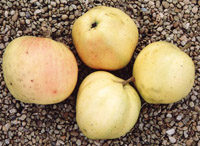 |
DR
HOGG Raised by the head gardener of Leonardslee in Sussex, introduced
around 1880 and named after the eminent pomologist Robert Hogg. A very
large cooking apple, possibly a seedling of Calville Blanche D’Hiver,
which is ripe in September. The flesh is rich and sweet. It is excellent
for baking and cooks to a purée. It stores until the end of October.
Attractive stripey blossom. T*. Pollination Group 4 |
|||
DRAP
D’OR - Or ‘Cloth of Gold’. There appear to
be at least three apples of this name, and it is a synonym of others.
This is the true Drap D’Or, or Vrai Drap D’Or. It was first
recorded with Le Lectier, in France, in 1628, as Drap D’Or de Bretagne,
and it has been assumed to have arisen in Brittany. It became confused,
as revealed by Duhamel Dumonceau, naming it Vraie Drap D’Or in his
‘Traité des Arbres Fruitiers’in 1768. It had already
arrived in England and was in Robert Furber’s Kensington nursery
catalogue in 1727. The place in the lists suggests it was ripe in September
or October. He listed it as ‘Drab De Or Apple’. It was noted
by Thomas Hitt in 1755, and was also in the nursery catalogue of Backhouse
of York, in 1816, and noted as a keeping apple. Richard Weston, in 1772,
said it “Is large; its skin is like a piece of cloth of gold, from
whence comes its name; its juice is good, but its pulp a little woolly,
and it is not a long keeping apple; It is esteemed by the curious.”
Coxe, in America, records in 1817, that he had obtained it from London.
From 1826 to 1842 it was in the collection catalogues of the London Horticultural
Society and briefly described as being yellow, roundish, large, for kitchen
use, of second quality and “handsome but proves of an inferior quality”.
Ronalds, in 1831, said it was a large sauce apple, of oblong shape, even
surface, straw-coloured and without any tinge of red, but sprinkled over
with small darkish points. He found it juicy but weak in flavour. Others
have said it was of top quality. Descriptions followed from Hogg in British
Pomology (1851), Scott in his ‘The Orchardist’ (1872), Leroy
in his ‘Dictionnaire de Pomologie’ (1873), and Hogg again
in ‘The Fruit Manual’ (1884). All are in agreement about its
characteristics. Scott described it as large, of top quality and in use
from October to January. “Roundish, sometimes oblong; skin smooth,
shining, fine pale yellow, interlaced with faint greenish stripes from
the base to the apex in the shade, but of a clearer deeper yellow in the
sun, the whole marked with patches of delicate brown russet, and sometimes
a shade of red, and strewn with numerous russety dots; stalk short, in
a wide smooth shallow cavity; eye small, closed, and set in a deep, wide,
irregular plaited basin; flesh yellowish white, tender, crisp, and juicy,
with a brisk vinous and sugary flavour. The tree is a free and healthy
grower, and good bearer, but requires a rich warm soil to bring it to
perfection.” Hogg considered it better as a culinary apple than
for dessert, and said the tree was free growing and bore early. Leroy
considered it of top quality, in France. Though it had disappeared from
Britain in the 20th century, it is still listed in the national collections
of France, Belgium and Switzerland. This apple is not the Drap D’Or
in the National Collection here, or that of the 1883 National Apple Congress.
Scions were kindly provided by Jérôme Munoz in 2019. His
nursery, Pépin’Hier, is in the Rhône-Alpes region of
France, in the south east. |
||||
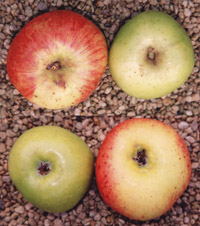 |
DROXFORD
An astonishing tree, first shown to us by owner, Chris Bennett, of Garrison
Hill, Droxford, Hampshire, many years ago. The tree was exceptionally
old, 8-9 ft in girth, hollow and immaculately boarded over where the hollow
boughs had been removed over the ages. His house was built in 1897 and
the tree surely existed well before then. It might have been part of an
orchard associated with the adjacent ‘Baker’s Arms’.
The tree probably had the ground level made up around it by 6-8ft, when
three terraced houses were built, along with cellars, and the spoil was
possibly used to bank up the garden. The trunk divides into two large
trunks just above ground now. The houses were built by the owner of the
Public House for his family. On the other side of Chris Bennett’s
house is Eden Lodge, built around 1750 at about the same time as the Public
House and though no other fruit trees now exist in the area, one or other
property probably had an orchard, where the terraced houses were built.
The tree produces large, flat cooking apples, lightly ribbed, pale green
with liberal scarlet streaks and flecks. When cooked lightly it keeps
its shape, is sweet, rich and tangy, though some might like to add a little
sugar. Pollination Group 3 |
|||
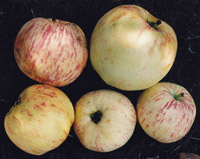 |
DUCHESS
OF OLDENBURG An early dessert/culinary apple, originally from
Russia and known since the early 1700s. It spread to Germany and Sweden
and was sent from there to England around 1820. There are numerous synonyms.
A beautiful fruit, with pale yellow skin, boldly striped and mottled with
red. The flesh is firm and deep cream, with a refreshing, juicy, savoury
flavour. A popular Victorian apple, it was once widely grown in the U.S.A.
and is still popular in Sweden and Russia because the trees are very hardy
and crop well. It does not store for long. Pollination Group 3 |
|||
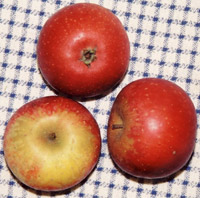 |
DUCHESS’S FAVOURITE Taylor, in ‘The Apples of England’, 1946, quotes from the Herefordshire Pomona of 1876-85 “A variety raised…in the late eighteenth and nineteenth century” but this quotation does not appear in the final edition of the Herefordshire Pomona. Bunyard (1920) in ‘A Handbook of Fruits’ says it was raised before 1823. It was in the collection of the London Horticultural Society by 1831, as Duchess of York’s Favourite. It is not known when the name changed. All agree that it was raised by Mr Cree of Cree’s nursery at Addlestone in Surrey and was named after the Duchess of York, a customer of his, residing at Oatlands Park, who was impressed by its striking red skin and crisp, juicy, rich white flesh, sometimes stained red. Strangely, it also has the synonym ‘Duchess of Gloucester’, and Taylor describes an apple of this name (in similar terms) on the same page as Duchess’s Favourite. It was a very popular dessert apple in Surrey and Kent and grown for the London market in the late nineteenth century. Apples are ripe from late September to October and will store for a while. Crops are usually very good. A middle/late season apple storing until November. Pollination Group 4 |
|||